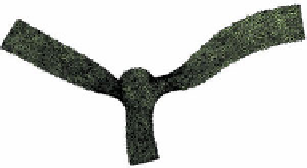Biomedical Engineering Reference
In-Depth Information
13.2.1 Surface remeshing with finite element conformal maps
The remeshing technique we present is based on a least square conformal parametri-
zation of a given mesh patch
that is also called discrete surface. We first assume
we have automatically split our initial triangulation into different mesh patches that
satisfy the three following conditions: have zero genus, have a boundary that is made
of at least one closed curve, have a moderate geometrical aspect ratio (see [29, 30]
for more details). Next we compute for each patch a finite element conformal map,
and then remesh the patch in the parametric space using standard 2D mesh generators
with a prescribed mesh size field. Fig. 13.1 shows the surface remeshing procedure
applied to part for the green mesh patch. For this example, the chosen mesh size field
is a constant.
Let us define now the discrete parametrization of a mesh patch
S
S
with a conformal
map. Parametrizing such a patch
S
is defining a map
u
(
x
)
(see Fig. 13.2):
3
)
∈
S
⊂
R
2
x
∈
S
⊂
R
→
u
(
x
(13.1)
2
that has a
well known parametrization. The least square conformal map as introduced by Levy
at al. [28] asks that the gradient of
u
and the gradient of
v
shall be as orthogonal
S
embedded in
that transforms continuously a 3D patch
S
into a patch
R
(1) Initial triangulation
(4) Final mesh
(2) Conformal parametrization
(3) Remeshing in the parametric space
Fig. 13.1.
Illustration of the presented surface remeshing procedure. (1) We start from an initial
triangulation that is automatically split into a minimal number of patches (green and orange patch
in this case) [29, 30]. (2) Next we compute for each patch the conformal map, and (3) remesh the
patch in the parametric space using standard 2D mesh generators. The final mesh is shown in (4)




